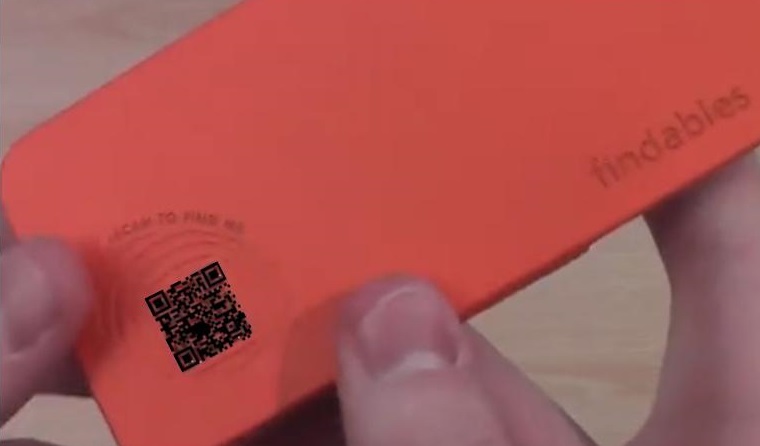The barcodes make it easier for devices that have gone missing to make their way back to their owners.
Findables has just announced that it is adding custom QR codes to the back of their smartphone cases which fit devices such as the iPhone 5 and the Galaxy S3.
These barcodes can be registered with the device owner’s information so that that data can be used if it goes missing.
If the smartphone is ever lost while the owner is out and about, the QR codes can be scanned to learn the information that was registered by that owner. The finder of the device can then contact the owner and arrange to have the smartphone returned. This is only one of a number of feature upgrades that the latest Findables case models will provide.
Aside from the QR codes, the cases also feature a unique fold-out bottom section to serve as a device stand.
 This makes it easier to view the screen of the device to watch video or to read web content or ebooks. The company is known for offering a number of different types of case, giving consumers many options from which to choose. It is the FlexStand case that offers the fold-out stand. The FlexWrap, on the other hand, doesn’t have a stand, but is a softer design to more snugly contain the device. The FlexSnap easily snaps onto the handset.
This makes it easier to view the screen of the device to watch video or to read web content or ebooks. The company is known for offering a number of different types of case, giving consumers many options from which to choose. It is the FlexStand case that offers the fold-out stand. The FlexWrap, on the other hand, doesn’t have a stand, but is a softer design to more snugly contain the device. The FlexSnap easily snaps onto the handset.
Each of these models all come with QR codes that can be registered so that regardless of the choice or the features the user wants, the smartphone will still have the added security benefit that will make it easier for it to be found and returned if it is ever lost.
Any apps for reading QR codes will work to scan the barcode and find the information, but it takes the Findables own application to register the unique black and white square in the first place. This process is simple and straightforward. The free application is downloaded from the Google Play store or the Apple App Store and when the barcode is scanned for the first time through this app, it opens an account creation page, through which the user’s contact information can be entered.
This new company is coming up with products that you’d expect James Bond to carry.
A startup company called Thalmic Labs, from Waterloo, Ontario, Canada, has started taking pre-orders for some of its gadgets which have been described as futuristic and have been compared to the types of devices that 007 would be seen using in his movies.
Among the products receiving the most attention is the Myo armband that it has had available for pre-order for a few months.
This particular gadget from Thalmic Labs picks up the forearm muscles’ electrical activities – particularly the movements for the control of the wrist and fingers as they gesture and perform various tasks – in order to translate those signals into commands. Stephen Lake, the co-founder and CEO of Thalmic, said that the advantage of the Myo armband over motion capture devices – such as Kinect from Microsoft or the Leap Motion Controller – is that users are not required to wave their hands around in front of a camera.
This gadget requires a smaller amount of workspace and less dramatic movements.
Lake explained that when cameras are used by gadgets, they need a larger workspace in which to function, and they are able to detect only exaggerated movements, or on the other hand, require a very tiny workspace with the fine type of movements that exist only in areas such as surgery. But the Myo is capable of detecting large arm motions as well as more subtle gestures of the fingers, moreover the user is not required to remain in one place and face a single direction.
He stated that what the company is most interested in achieving in terms of the gadgets that it produces, “is the next evolution of smart devices–in getting away from sitting in front of a computer.”
At the moment, the applications for the Myo have to do with using the armband as a replacement for other types of controllers, such as to control a tool or weapon in a video game, to turn up the volume on a computer, or to flick the wrist in order to move to the next slide in a presentation. Lake also added that “We’ve also played with things like the Sphero robotic ball and a remote-controlled helicopter drone.”
 This makes it easier to view the screen of the device to watch video or to read web content or ebooks. The company is known for offering a number of different types of case, giving consumers many options from which to choose. It is the FlexStand case that offers the fold-out stand. The FlexWrap, on the other hand, doesn’t have a stand, but is a softer design to more snugly contain the device. The FlexSnap easily snaps onto the handset.
This makes it easier to view the screen of the device to watch video or to read web content or ebooks. The company is known for offering a number of different types of case, giving consumers many options from which to choose. It is the FlexStand case that offers the fold-out stand. The FlexWrap, on the other hand, doesn’t have a stand, but is a softer design to more snugly contain the device. The FlexSnap easily snaps onto the handset.
